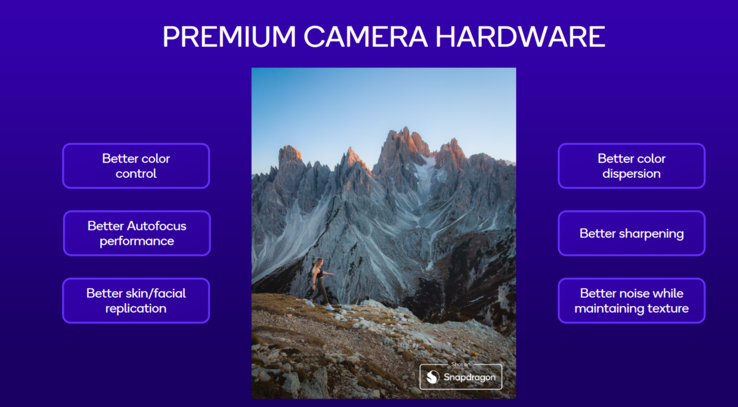Now that the flagship Snapdragon 8 Gen 3 is out of the way, Qualcomm has started rolling out its mid-range SoCs for 2024. The first one out of the door is the Snapdragon 7 Gen 3 (codenamed SM7550-AB), which succeeds the Snapdragon 7+ Gen 2 and the Snapdragon 7s Gen 2 in a way.
It, too, is manufactured on a "4 nm" node, but Qualcomm neglects to mention if it is TSMC or Samsung Foundry. The Snapdragon 7 Gen 3 will power smartphones from Oppo, Vivo, ZTE, iQOO, Honor, OnePlus, Sony, Redmi, Realme and more. Honor and Vivo phones powered by the AP will be launched by the end of this month.
Top 10
» Le Top 10 des PC portables multimédia
» Le Top 10 des PC portables de jeu
» Le Top 10 des PC portables de jeu légers
» Le Top 10 des ordinateurs portables bureautiques
» Le Top 10 des PC portables bureautiques premium/professionnels
» Le Top 10 des Stations de travail mobiles
» Le Top 10 des Ultraportables
» Le Top 10 des Ultrabooks
» Le Top 10 des Convertibles
» Le Top 10 des Tablettes
» Le Top 10 des Tablettes Windows
» Le Top 10 des Smartphones
» Le Top 10 des PC Portables á moins de 300 euros
» Le Top 10 des PC Portables á moins de 500 euros
» Le Top 25 des meilleurs écrans d'ordinateurs
Qualcomm says the Snapdragon 7 Gen 3 uses four high-performance cores with a peak frequency of 2.63 GHz and four efficiency cores and is divided into a 1+3+4 arrangement, with the prime core operating at 2.6 GHz, the p-core cluster at 2.4 GHz and the e-core cluster at 1.8 GHz.
The chipmaker claims the Snapdragon 7 Gen 3 is 15% faster than the Snapdragon 7 Gen 1 in CPU and 50% faster in GPU while being 20% more power-efficient. Weirdly, it uses an Adreno 720 GPU instead of an Adreno 725 found on the Snapdragon 7+ Gen 2. As always, Qualcomm hasn't specified its clock speed, instead choosing to focus more on its Snapdragon Super Resolution AI upscaling tech for gaming.
Moving on, Qualcomm also advertises a boatload of AI-powered features, such as improved face detection and activity recognition. The Snapdragon 7 Gen 3 uses Qualcomm's X63 5G modem that supports SA/NSA networks and comes with a sub-6 GHz and mmWave radio. Other wireless connectivity options include Wi-Fi 6E, Bluetooth 5.3, and Bluetooth LE audio, complete with aptX Voice, aptX Lossless and aptX Adaptive support. Audiophiles will be pleased to know that it can output 26-bit 44.1 KHz music wirelessly.
Devices powered by the Snapdragon 7 Gen 3 can use a single 200 MP camera sensor for photos. Other combinations include one 64 MP sensor for 30 FPS ZSL recording, a 32+ 21 MP sensor or three 21 MP sensors. It also leverages the NPU for AI noise reduction, AI Video Retouch and AI Remosaic, all three of which supposedly improve the quality of images captured.
OEMs can use a 4K 60 Hz display with their Snapdragon 7 Gen 3-powered phones. Nobody other than Sony seems to be doing that, so others will likely stick to the more conventional 1080p 168 Hz or 1440p 120 Hz configurations, complete with HDR, HDR10, HDR10+ Ultra HDR, and Dolby Vision support. Additionally, it can output a 4K 60 FPS video stream to an external monitor.
Other Snapdragon 7 Gen 3 features include support for up to 16 GB of LPDDR5 3200, LPDDR4x 2133 memory, UFS 3.1 storage, GPS, GLONASS, NavIC, BeiDOU and QZSS navigation protocols.
Source(s)
Qualcomm
































